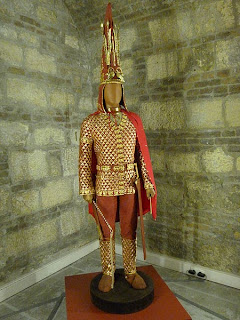 |
| Grecian dress, rear |
 |
| Kore statue, c. 530 BCE |
|
 |
| Pally's "Grecian Maxi Dress" |
I have just returned from one vacation, and am preparing to head out on another. Right now I'm too exhausted to engage in original thought, or even finish one of my nearly finished drafts. However, I did find some intriguing images to share with my readers on this hot summer (or boring winter, depending on where you live) day.
The image on the left is a picture of statue of a maiden wearing a peplos, a simple garment formed by draping a sheet or tube of fabric around the body and pinning it at the shoulders. It is dated to 530 BCE.
The images on the right are from Neiman Marcus's website; Google Shopping found it for me today. The website calls it Rachel Pally's "Birdie Draped Grecian Maxi Dress". According to her
website, Ms. Pally is a young California-based designer "distinguished by her ability to blend the 'easy and elegant' with the 'chic and classic.'" Taking into consideration the stylization of the Kore statue as compared to a photograph of a living woman, the dresses and hairstyles depicted are surprisingly alike.
The Kore's
peplos likely was made from fine wool, as wool was the fabric most commonly used for Greek clothing in the 6th century BCE. It must have been woven from a fine wool, perhaps loosely woven, so that it would drape fluidly and flatteringly. Scientific analysis of the Acropolis's Kore statue, which detected minute traces of brightly colored paints, suggest that the Kore was originally wearing a
red peplos, but other Kore statues, and likely living Greek maidens, may well have worn blue instead. Wool takes vegetable dyes very well, including woad, an indigotin-containing plant common to Europe and used since ancient times to dye textiles blue. Wikipedia states, in its article about
Kore statues, that when Kore were painted the "[d]ominant color was the red for the lips and hair, red and blue for the clothes, and black for the eyes." Wool is naturally soil repellent and tends to shrink and felt when washed, so the Kore's dress likely would not have been washed. but would have been carefully aired and brushed to remove dust, and perhaps stored in a chest with dried herbs to discourage moths.
Neiman Marcus's dress wouldn't be washed, either; according to the description on the Neiman Marcus website, the Pally dress is made from
modal and must be dry cleaned. The company's website describes Rachel Pally's Grecian Maxi Dress thus:
Stretch jersey.
Cowl neckline; sleeveless.
Caftan overlay top; cape back.
Cinched waist.
Rippled A-line skirt.
Hem falls to floor.
Modal/spandex; dry clean.
Made in USA.
I am impressed by Ms. Pally's success at recreating the elegant, humble effect of the ancient peplos with modern techniques and fabrics. But what's more impressive is that after 2,500 years, the same look still appeals to Europeans and other cultural descendants of the ancient Greeks. These images are powerful support for the idea that fashion really does reuse the best ideas, and what is old, perhaps even very old, may come around and be new again.
The Kore statue shown is in the Acropolis Museum, Athens, Greece; the photograph is courtesy of Wikimedia Commons. The photographs of the Grecian Maxi Dress are from the Neiman Marcus website.



